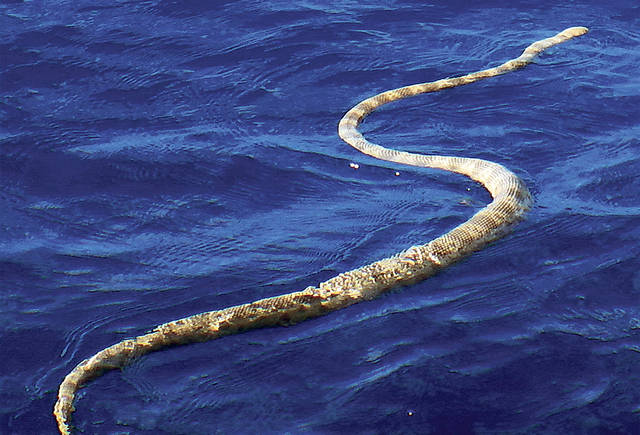KELSO REEF, AUSTRALIA >> After sitting out a week of rain in Magnetic Island Marina, we’re back in flat water, moored on another of the Great Barrier Reef’s pristine outer reefs. Snorkeling here at Kelso Reef is as good as it gets, but even so, we don’t have to get in the water to be thrilled. We just stand on the deck.
While sailing between the mainland and the outer reefs these last few weeks, we’ve seen four sea snakes sunbathing on the water’s surface. Three dived before we could turn the boat around for pictures, but one, a tan-colored beauty with dark saddles on its back, totally ignored us, continuing to nap as we circled.
The 15 species of sea snakes that live on Australia’s reefs are bold, because they’re packing. All carry cobra-type venom stored in cheek glands connected to two front fangs. Injected toxin paralyzes muscles almost immediately, handy for halting fast-swimming prey, such as the bottom-dwelling fish that most snakes like to eat.
The good news is that sea snakes don’t waste their venom on snorkelers or divers. Australia reports no deaths from sea snake bites.
Even though we’ve seen sea snakes basking on the water’s surface this month, I’ve not seen a single one while snorkeling. That’s partly by chance, but it may also be because some sea snakes don’t like to travel.
In a study of olive sea snakes, the Great Barrier Reef’s most common species, researchers found the snakes’ foraging areas were only half an acre. When workers moved some individuals from their home reef to an adjacent one 200 yards away, none crossed the sandy channel to get back.
That might explain why sea snakes are common on some reefs and absent on others, but it makes me wonder about the snakes we see basking on the surface miles from the nearest coral reefs. Maybe like us humans, some sea snakes are wanderers and others are homebodies.
All sea snakes are air breathers, but because they have one cylindrical lung nearly as long as their bodies, they can stay submerged for up to two hours.
Olive sea snakes come in shades of solid green, gray or golden yellow. Our first three snake sightings were olives. The species has light sensors on its flat, paddlelike tail, a feature that tells the snake whether its rear end is sticking out. When you’re 6 feet long, eye spots on your tail are handy for hiding under a coral head.
For us sailors, though, eyes peering through polarized sunglasses are all we need to spot a sea snake snoozing on the water’s surface.
I know I’ll never convince people who fear snakes that they’re fun snorkeling companions. But even those with phobias might appreciate seeing, from the deck of a boat, a rare marine animal in its natural element.
Or not, if it’s a snake.
Reach Susan Scott at susanscott.net Opens in a new tab.

